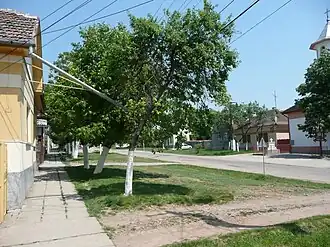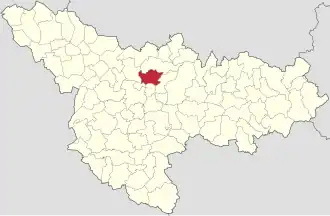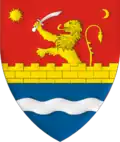Giarmata
Giarmata | |
|---|---|
 Street in Giarmata | |
 Location in Timiș County | |
 Giarmata Location in Romania | |
| Coordinates: 45°50′N 21°19′E / 45.833°N 21.317°E | |
| Country | Romania |
| County | Timiș |
| Government | |
| • Mayor (2020–2024) | Claudiu Mihălceanu[1] (PMP) |
Area | 72.99 km2 (28.18 sq mi) |
| Population (2021-12-01)[3] | 6,831 |
| • Density | 94/km2 (240/sq mi) |
| Time zone | EET/EEST (UTC+2/+3) |
| Postal code | 307210–307211 |
| Vehicle reg. | TM |
| Website | primariagiarmata |
Giarmata (Romanian pronunciation: [ˈdʒjarmata]; until 1925 Iermata Timișană;[4][5] Hungarian: Temesgyarmat; German: Jahrmarkt) is a commune in Timiș County, Romania. It is composed of two villages, Cerneteaz and Giarmata (commune seat).
History
Traces of a Neolithic settlement and materials of Daco-Roman origin were discovered on the territory of the commune. During the formation of the Romanian people, on the territory of the commune the native Daco-Roman population continued to live in the form of a village community, and at the beginning of feudalism there was even a fairly strong voivodeship, recorded in the few narrative sources of that time. Thus, on the occasion of the great Mongol invasion of 1241, the Giarmata Voivodeship is mentioned.[6]
His name is derived from a Hungarian tribal name Gyarmat. Giarmata is first mentioned in the registers of papal tithes from 1332–1337 with the names of Garmad and Carmad of Temes County.[7] With the names of Zamar and Garmat, the locality is mentioned in 1334, so that a year later it would be designated as Germad.[8] Later, in 1428, the locality is recorded as Giarmath.[9]Between the 15th–18th centuries, it formed two villages, which in 1767 were located on two adjacent hills. In 1407, Sigismund granted Kisgyarmat to Miklós Vajdafi of Vajdafalva and his son Tamás. The family took on the noble name in 1418 and owned the two villages until 1515–20. After the expulsion of the Turks after the Great Turkish War, Big-Giarmata (Nagygyarmat) consisted of 36 houses and Small-Giarmata (Kisgyarmat) of 28, and both were inhabited by Serbs and Romanians.
The modern history of the locality begins with the conquest of Banat by the Austrians, in 1717. Under the new administration, Giarmata is colonized by Germans, who will form the majority of the population for almost two centuries. The Austrian Chamber first settled 20 German families from the Mainz countryside in 1722–24, then another 30 in 1728–30, this time from the villages of Ellstein, Schimdendenwaag, Kreuznach, Höchst and Zweibrücken. In 1730, a Roman Catholic parish was founded in the settlement. In 1737–40, about 1200 refugees from Versec and other settlements in the South Banat, who had arrived to escape the Turkish attack, swelled its population. In 1754 the Germans built their Roman Catholic Church, and in 1764 Josef Franz Knoll, an administrative officer of the Crown and Chamber domain. Between 1741 and 1763, Germans mainly from the Archbishopric of Mainz, the Pfalz and Lorraine settled there. 100 Serbian and Romanian families were moved partly to Románkécsa in 1765 and partly to Klári in 1768. According to Wolfgang von Kempelen's 1767 note, 238 new families arrived in their place, and in the summer of 1770, 1,005 people arrived, mainly from Luxembourg, Lorraine, the County of Siegen, Trier and the Pfalz. The two settlements, Alt- und Neujarmat ("Old and New Iarmata"), then became a single municipality, the streetscape of which was also changed during the relocation of the Serbs and Romanians. In 1781, it was purchased by Mihály Sándor at an auction, who saled it to István Gyürky in 1794. Half of the estate was inherited by Lajos Ambrózy, who after 1806 expanded it with four streets in the south and west, where so-called "contractualists" moved. In 1807, it received the privilege of a market town. The colonization lasted until around 1800 and made Giarmata a strong rural center of the Banat Swabians. The pharmacy opened in 1883 and in 1888 the Temesgyarmatai Takarék- és Hitelegylet Temesgyarmata Savings and Credit Union was founded. Between 1904 and 1908, 547 of its inhabitants emigrated to the United States, but emigration only reached its peak in 1923–24. After 1909, Baron Gyula Csávossy surveyed new plots. In the same year, Jenő Gudenus's castle was converted into a school. After 1956, Giarmata-Vii (Kisgyarmatapuszta) separated from it. Its German inhabitants left in the second half of the 20th century. Their place was gradually taken by Romanians from 1945.
In 1910, out of 5,267 inhabitants, 4,782 declared themselves to be German, 318 Romanian and 157 Hungarian; 4,916 Roman Catholic and 309 Orthodox.
In 2002, out of 4,405 inhabitants, 4,279 declared themselves to be Romanian and 68 Hungarian; 3,887 Orthodox, 279 Pentecostal and 133 Roman Catholic.
Demographics
- Orthodox (80.3%)
- Pentecostals (6.31%)
- Roman Catholics (2.60%)
- Unknown (7.95%)
- Others (2.87%)
Giarmata had a population of 6,502 inhabitants at the 2011 census, up 20% from the 2002 census. Most inhabitants are Romanians (88.63%), with a minority of Roma (1.65%). For 7.84% of the population, ethnicity is unknown.[10] By religion, most inhabitants are Orthodox (80.27%), but there are also minorities of Pentecostals (6.31%) and Roman Catholics (2.6%). For 7.95% of the population, religious affiliation is unknown.[11]
| Census[12] | Ethnic composition | ||||
|---|---|---|---|---|---|
| Year | Population | Romanians | Hungarians | Germans | Roma |
| 1880 | 6,165 | 1,385 | 133 | 4,578 | – |
| 1890 | 7,081 | 1,652 | 104 | 5,261 | – |
| 1900 | 6,776 | 1,570 | 154 | 4,974 | – |
| 1910 | 6,599 | 1,482 | 174 | 4,826 | – |
| 1920 | 6,427 | 1,548 | 206 | 4,661 | – |
| 1930 | 6,393 | 1,514 | 168 | 4,678 | 18 |
| 1941 | 6,311 | 1,448 | 120 | 4,733 | – |
| 1956 | 5,582 | 1,857 | 82 | 3,632 | – |
| 1966 | 6,147 | 2,374 | 61 | 3,676 | 23 |
| 1977 | 6,333 | 2,749 | 108 | 3,417 | 36 |
| 1992 | 5,162 | 4,868 | 105 | 87 | 49 |
| 2002 | 5,407 | 5,069 | 144 | 23 | 108 |
| 2011 | 6,502 | 5,763 | 64 | 15 | 107 |
References
- ^ "Results of the 2020 local elections". Central Electoral Bureau. Retrieved 16 June 2021.
- ^ "Primăria Giarmata". Ghidul Primăriilor.
- ^ "Populaţia rezidentă după grupa de vârstă, pe județe și municipii, orașe, comune, la 1 decembrie 2021" (XLS). National Institute of Statistics.
- ^ Moldovan, Silvestru; Togan, Nicolae (1919). Dicționarul numirilor de localități cu poporațiune română din Transilvania, Banat, Crișana și Maramurăș (PDF) (2nd ed.). Sibiu: ASTRA. p. 95.
- ^ "Lege nr. 95 din 13 iunie 1925 pentru Unificarea Administrativă". Portal Legislativ.
- ^ "Istorie". Primăria comunei Giarmata.
- ^ Lotreanu, Ioan (1935). Monografia Banatului. Timișoara: Institutul de Arte Grafice „Țara”. pp. 194–195.
- ^ Țintă, Aurel (1972). Colonizările habsburgice în Banat. Timișoara: Facla. p. 158.
- ^ Suciu, Coriolan (1967). Dicționar istoric al localităților din Transilvania. Vol. I. Bucharest: Editura Academiei Republicii Socialiste România. p. 261.
- ^ a b "Tab8. Populația stabilă după etnie – județe, municipii, orașe, comune". Institutul Național de Statistică. Archived from the original on 2016-01-18. Retrieved 2021-10-09.
- ^ a b "Tab13. Populația stabilă după religie – județe, municipii, orașe, comune". Institutul Național de Statistică. Archived from the original on 2020-08-07. Retrieved 2021-10-09.
- ^ Varga, E. Árpád. "Temes megye településeinek etnikai (anyanyelvi/nemzetiségi) adatai 1880-2002" (PDF). Archived from the original (PDF) on 2007-06-10. Retrieved 2021-10-09.
